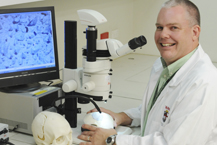
Project leader RPH biomedical engineer Alan Kop
Patients requiring cranial reconstructions will be helped to regrow sections of their own skulls in a radical new procedure involving human stem cells and advanced 3-D printing technology.
Researchers at Royal Perth Hospital will perform the procedure on patients whose skulls have been severely damaged, or who have had a piece of skull removed to enable brain surgery or relieve pressure caused by swelling of the brain.
If successful, the new procedure stands to transform cranial reconstructions and provide significant cost savings by reducing complications and surgical time.
The project is one of nine research projects being funded in the latest round of Research Translation Project grants, which encourage research and the translation of research outcomes into effective healthcare policy and practice.
The new procedure is expected to overcome problems of infection and bone resorption – common complications of traditional methods of cranial reconstruction – and halve the surgical time needed to replace the excised bone.
Traditionally, an excised fragment is stored in a freezer and reimplanted once swelling of the brain subsides. In Western Australia, titanium plates are frequently used as an alternative to the patient’s original bone. However, the risk of infection remains for the life of the patient and the plates can cause problems in cold climates.
In the new procedure, a porous bioceramic 'scaffold' – which replicates the excised fragment with pinpoint accuracy – is created using sophisticated 3-D printing technology. Several days before the scaffold is due to be fitted into the skull cavity, it is infused with stem cells.
Researchers believe this infusion will encourage surrounding bone tissue to grow across the scaffold and – over a period of years – replace the trellis-like structure entirely.
Biomedical engineer Alan Kop, who heads the project, says the beauty of the new procedure is that ultimately the skull will have been repaired using the patient’s own regrown bone.